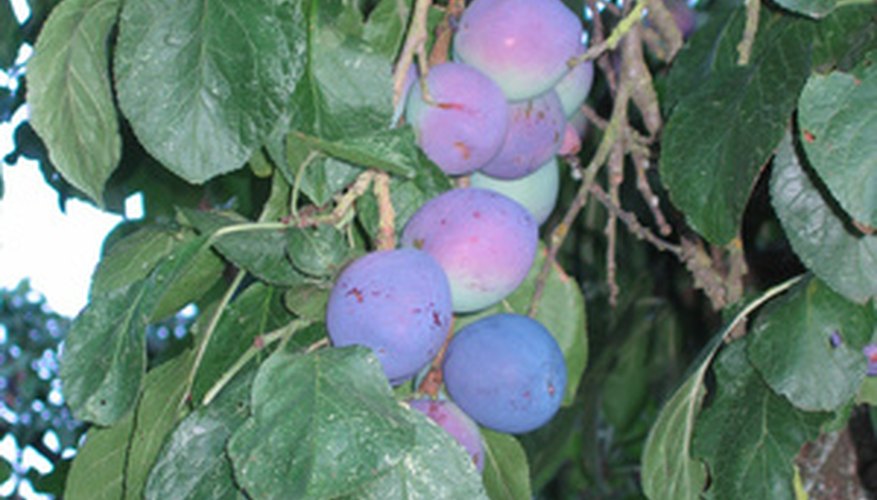Several methods of propagation allow you to grow new plum trees. Attaching a clipping from one plum tree to another living tree is call grafting. With grafting, you can go as far as to grow several different varieties of fruit on a single host tree. Growing from plum pits is an easier alternative to grafting. However, the new plum tree's fruits are likely to be different than and possibly inferior to the original. Propagation from cuttings is probably the easiest method of growing a new plum tree.
- Several methods of propagation allow you to grow new plum trees.
- Growing from plum pits is an easier alternative to grafting.
Cut off a section of dormant wood with sharp pruning shears. Choose a cutting from last year's growth. The section needs to be approximately 12 to 18 inches long and pencil-thick.
Strip the lower leaves and scrape about 1 inch of the bark from the lower stem. Insert the stem 2 inches deep into a peat/sand potting mix. Leave one bud poking up out of the soil.
- Strip the lower leaves and scrape about 1 inch of the bark from the lower stem.
- Insert the stem 2 inches deep into a peat/sand potting mix.
Fill a small tray with gravel and water. Place the pot on top to maintain high humidity. Water cutting and mist daily with water until established.
Transplant your plum sprig into a larger pot after roots develop. Take outside and place the pot in a sheltered location for one year. Finally, transplant your plum tree to your chosen location in the ground.
Clean pulp from around the pit with water. Test your plum seed by dropping it into a cup of water. If it floats it is not going to grow and you will need to try another seed.
- Clean pulp from around the pit with water.
- Test your plum seed by dropping it into a cup of water.
Put seed into a zip-lock bag of moist peat moss. Seal the bag and place it in your refrigerator, about 4.44 degrees Celsius, for six to eight weeks.
Check your seed regularly for signs of growth; look through the bag rather than unsealing the bag. As soon as your plum seed breaks dormancy, it is ready to plant in the same way you plant a cutting.
Look for pencil-thick twigs with leaf buds; cut in late winter while the tree is dormant but not frozen. Cleanly cut sections in the middle of the branch at an angle. Cutting newer growth is best, but just to be sure, gather several different sections of 12-inch sprigs.
Cover cuttings completely with damp sphagnum moss and place in a zip-lock bag, according to certified nursery technician Jim Bishop (Mr. Grow). Place your bag of cuttings in your refrigerator until danger of frost has passed.
- Look for pencil-thick twigs with leaf buds; cut in late winter while the tree is dormant but not frozen.
- Cover cuttings completely with damp sphagnum moss and place in a zip-lock bag, according to certified nursery technician Jim Bishop (Mr. Grow).
Take your bag of cuttings outside to the host tree. Make angled cuts on the host tree's branches where you want to attach your cuttings. Make a matching cut on the lower end of your cuttings so the two will match perfectly.
Fit the two cuts together and bind with floral tape. Wrap with cellophane plastic. Check periodically to make sure the new branch does not dry out or come apart.
TIP
Grocery store fruit seeds are usually hybrid and fruit may not be the same as the original. Experiment with different grafting cuts. The goal is to cleanly remove some of the bark to allow the tissues just under the bark to fuse. The host plant provides nourishment and, over time, and with a little luck, the new branch will grow and produce fruit identical to the plum tree from which it was taken.
